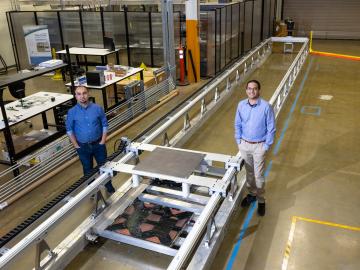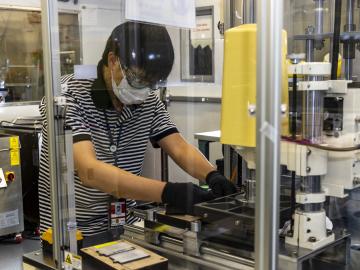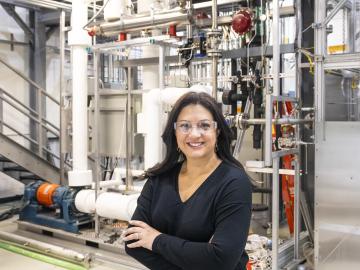
Filter News
Area of Research
- Biological Systems (1)
- Biology and Environment (23)
- Computational Biology (1)
- Electricity and Smart Grid (1)
- Energy Science (40)
- Fusion and Fission (21)
- Fusion Energy (4)
- Isotopes (7)
- Materials (23)
- Materials for Computing (3)
- National Security (12)
- Neutron Science (14)
- Nuclear Science and Technology (17)
- Supercomputing (36)
News Type
News Topics
- (-) Artificial Intelligence (79)
- (-) Biomedical (44)
- (-) Energy Storage (37)
- (-) Grid (34)
- (-) Nuclear Energy (71)
- (-) Simulation (44)
- (-) Space Exploration (13)
- 3-D Printing/Advanced Manufacturing (60)
- Advanced Reactors (13)
- Big Data (50)
- Bioenergy (70)
- Biology (82)
- Biotechnology (26)
- Buildings (35)
- Chemical Sciences (37)
- Clean Water (17)
- Composites (12)
- Computer Science (117)
- Coronavirus (20)
- Critical Materials (6)
- Cybersecurity (14)
- Education (2)
- Emergency (3)
- Environment (124)
- Exascale Computing (51)
- Fossil Energy (6)
- Frontier (45)
- Fusion (40)
- High-Performance Computing (82)
- Hydropower (6)
- Isotopes (35)
- ITER (4)
- Machine Learning (40)
- Materials (53)
- Materials Science (64)
- Mathematics (9)
- Mercury (7)
- Microelectronics (3)
- Microscopy (27)
- Molten Salt (2)
- Nanotechnology (21)
- National Security (63)
- Neutron Science (85)
- Partnerships (36)
- Physics (39)
- Polymers (12)
- Quantum Computing (35)
- Quantum Science (49)
- Security (18)
- Software (1)
- Statistics (2)
- Summit (40)
- Transportation (35)
Media Contacts

Scientists at ORNL and the University of Wisconsin–Madison have discovered that genetically distinct populations within the same species of fungi can produce unique mixes of secondary metabolites, which are organic compounds with applications in

An ORNL-led team comprising researchers from multiple DOE national laboratories is using artificial intelligence and computational screening techniques – in combination with experimental validation – to identify and design five promising drug therapy approaches to target the SARS-CoV-2 virus.

Consumer buy-in is key to the future of a decarbonized transportation sector in which electric vehicles largely replace today’s conventionally fueled cars and trucks.

Deborah Frincke, one of the nation’s preeminent computer scientists and cybersecurity experts, serves as associate laboratory director of ORNL’s National Security Science Directorate. Credit: Carlos Jones/ORNL, U.S. Dept. of Energy

Oak Ridge National Laboratory expertise in fission and fusion has come together to form a new collaboration, the Fusion Energy Reactor Models Integrator, or FERMI

At the Department of Energy’s Oak Ridge National Laboratory, scientists use artificial intelligence, or AI, to accelerate the discovery and development of materials for energy and information technologies.

Belinda Akpa is a chemical engineer with a talent for tackling big challenges and fostering inclusivity and diversity in the next generation of scientists.

In his career focused on energy storage science, Jianlin Li has learned that discovering new ways to process and assemble batteries is just as important as the development of new materials.

Through a consortium of Department of Energy national laboratories, ORNL scientists are applying their expertise to provide solutions that enable the commercialization of emission-free hydrogen fuel cell technology for heavy-duty

Toward the goal of bringing the next generation of nuclear power reactor technology online this decade, ORNL and Analysis and Measurement Services Corporation have successfully completed loop testing of instrument and control sensors for an advanced reactor design for small modular reactors.


